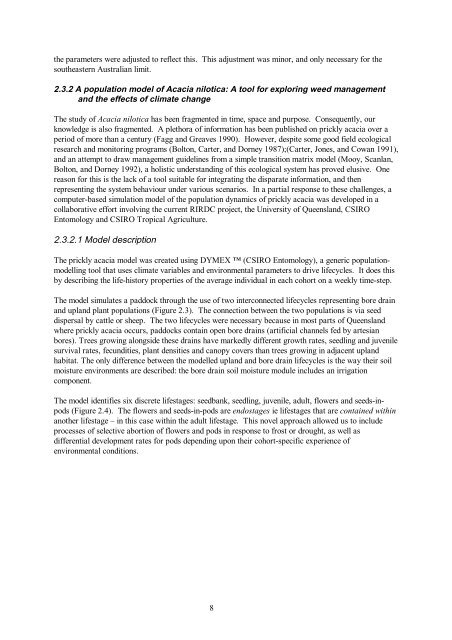EXOTIC WOODY WEEDS Use of simulation models to predict future ...
EXOTIC WOODY WEEDS Use of simulation models to predict future ...
EXOTIC WOODY WEEDS Use of simulation models to predict future ...
You also want an ePaper? Increase the reach of your titles
YUMPU automatically turns print PDFs into web optimized ePapers that Google loves.
the parameters were adjusted <strong>to</strong> reflect this. This adjustment was minor, and only necessary for the<br />
southeastern Australian limit.<br />
2.3.2 A population model <strong>of</strong> Acacia nilotica: A <strong>to</strong>ol for exploring weed management<br />
and the effects <strong>of</strong> climate change<br />
The study <strong>of</strong> Acacia nilotica has been fragmented in time, space and purpose. Consequently, our<br />
knowledge is also fragmented. A plethora <strong>of</strong> information has been published on prickly acacia over a<br />
period <strong>of</strong> more than a century (Fagg and Greaves 1990). However, despite some good field ecological<br />
research and moni<strong>to</strong>ring programs (Bol<strong>to</strong>n, Carter, and Dorney 1987);(Carter, Jones, and Cowan 1991),<br />
and an attempt <strong>to</strong> draw management guidelines from a simple transition matrix model (Mooy, Scanlan,<br />
Bol<strong>to</strong>n, and Dorney 1992), a holistic understanding <strong>of</strong> this ecological system has proved elusive. One<br />
reason for this is the lack <strong>of</strong> a <strong>to</strong>ol suitable for integrating the disparate information, and then<br />
representing the system behaviour under various scenarios. In a partial response <strong>to</strong> these challenges, a<br />
computer-based <strong>simulation</strong> model <strong>of</strong> the population dynamics <strong>of</strong> prickly acacia was developed in a<br />
collaborative effort involving the current RIRDC project, the University <strong>of</strong> Queensland, CSIRO<br />
En<strong>to</strong>mology and CSIRO Tropical Agriculture.<br />
2.3.2.1 Model description<br />
The prickly acacia model was created using DYMEX (CSIRO En<strong>to</strong>mology), a generic populationmodelling<br />
<strong>to</strong>ol that uses climate variables and environmental parameters <strong>to</strong> drive lifecycles. It does this<br />
by describing the life-his<strong>to</strong>ry properties <strong>of</strong> the average individual in each cohort on a weekly time-step.<br />
The model simulates a paddock through the use <strong>of</strong> two interconnected lifecycles representing bore drain<br />
and upland plant populations (Figure 2.3). The connection between the two populations is via seed<br />
dispersal by cattle or sheep. The two lifecycles were necessary because in most parts <strong>of</strong> Queensland<br />
where prickly acacia occurs, paddocks contain open bore drains (artificial channels fed by artesian<br />
bores). Trees growing alongside these drains have markedly different growth rates, seedling and juvenile<br />
survival rates, fecundities, plant densities and canopy covers than trees growing in adjacent upland<br />
habitat. The only difference between the modelled upland and bore drain lifecycles is the way their soil<br />
moisture environments are described: the bore drain soil moisture module includes an irrigation<br />
component.<br />
The model identifies six discrete lifestages: seedbank, seedling, juvenile, adult, flowers and seeds-inpods<br />
(Figure 2.4). The flowers and seeds-in-pods are endostages ie lifestages that are contained within<br />
another lifestage – in this case within the adult lifestage. This novel approach allowed us <strong>to</strong> include<br />
processes <strong>of</strong> selective abortion <strong>of</strong> flowers and pods in response <strong>to</strong> frost or drought, as well as<br />
differential development rates for pods depending upon their cohort-specific experience <strong>of</strong><br />
environmental conditions.<br />
8

















